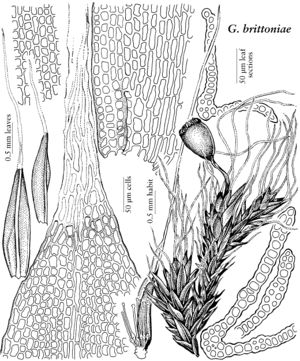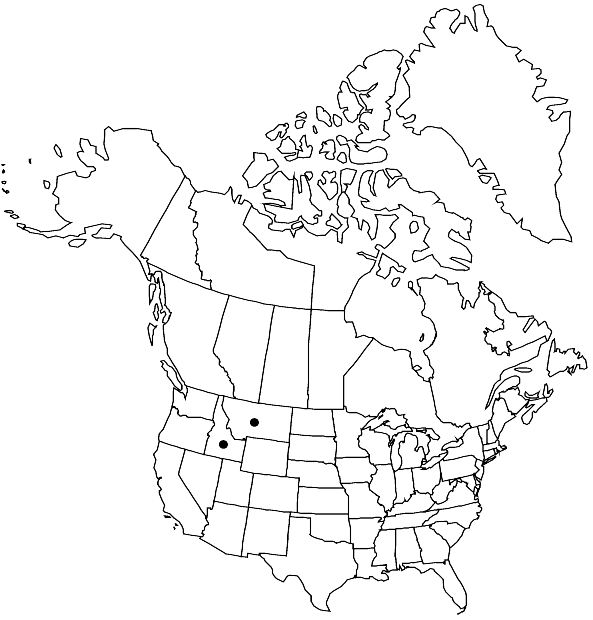Grimmia brittoniae
Bull. Torrey Bot. Club 27: 316, fig. 19. 1900,.
Plants in extremely hoary, compact glaucous cushions, brown inside. Stems 2–3 cm, central strand absent. Leaves loosely appressed to slightly contorted when dry, erectopatent when moist, lanceolate, 0.5–1 × 0.3–0.4 mm, keeled, margins narrowly recurved on both sides, awns 2–4 mm, smooth, flattened proximally, decurrent, costa weak, projecting on abaxial side; basal juxacostal laminal cells rectangular, straight to slightly sinuose, thick-walled; basal marginal laminal cells quadrate with thickened transverse walls; medial laminal cells short-rectangular, slightly sinuose, thick-walled; distal laminal cells 1-stratose, margins 1-stratose. Gemmae absent. Sexual condition dioicous. Seta flexuose, 2 mm. Capsule occasionally present, exserted, brownish, ovoid, wide-mouthed, exothecial cells thin-walled, annulus present, operculum conical, peristome teeth yellow, split and perforated distally, slightly papillose.
Habitat: Vertical faces of shaded, calcareous cliffs
Elevation: moderate elevations (500-700 m)
Discussion
Of conservation concern.
Grimmia brittoniae is an endemic of western Montana and northern Idaho. It was described by Williams based on a set of specimens that he collected near Columbia Falls. It grows in warm, dry but climatically moist valley-bottom or piedmont forests dominated by Douglas fir. It is distinctive and easily recognized in the field. The often extensive cushions found on rocky underhangs are a characteristic blue-green color when moist, cracking into polygonal patterns when dry. The extremely long awns at once separate it from all other species of the genus. Grimmia brittoniae can be confused only with small forms of G. funalis, which also may grow in compact hoary cushions that are glaucous green in the distal part and brown inside. J. Muñoz (2000) synonymized G. brittoniae with that species. H. C. Greven and T. Spribille (1999), however, had already demonstrated that in G. funalis the leaves are usually spirally curved, the distal areolation is 2-stratose, the proximal leaves are blackish with short awns, the margins are plane or recurved on one side, and the basal cells are linear, thick-walled, and sinuose. In addition, G. funalis is characterized by male plants growing in separate cushions, with muticous to very short-awned leaves. Male plants of G. brittoniae grow intermingled with female ones and can hardly be separated from them. Grimmia brittoniae is more closely related to G. orbicularis. The leaves of both species are similar. However, the awns of the latter are much shorter, it is autoicous, usually with capsules on arcuate setae, the peristome teeth are broad, cribrose, and irregularly cleft at the apex, and the operculum is mammillate. Although Williams originally described G. brittoniae as having concave leaves with plane, sometimes 2-stratose margins, the leaves are keeled distally, and the margins are narrowly recurved and only very rarely 2-stratose. The recurved margins, however, are only present in leaves still attached to the stems; once detached and pressed under a cover glass, the margins appear plane.
Selected References
None.

